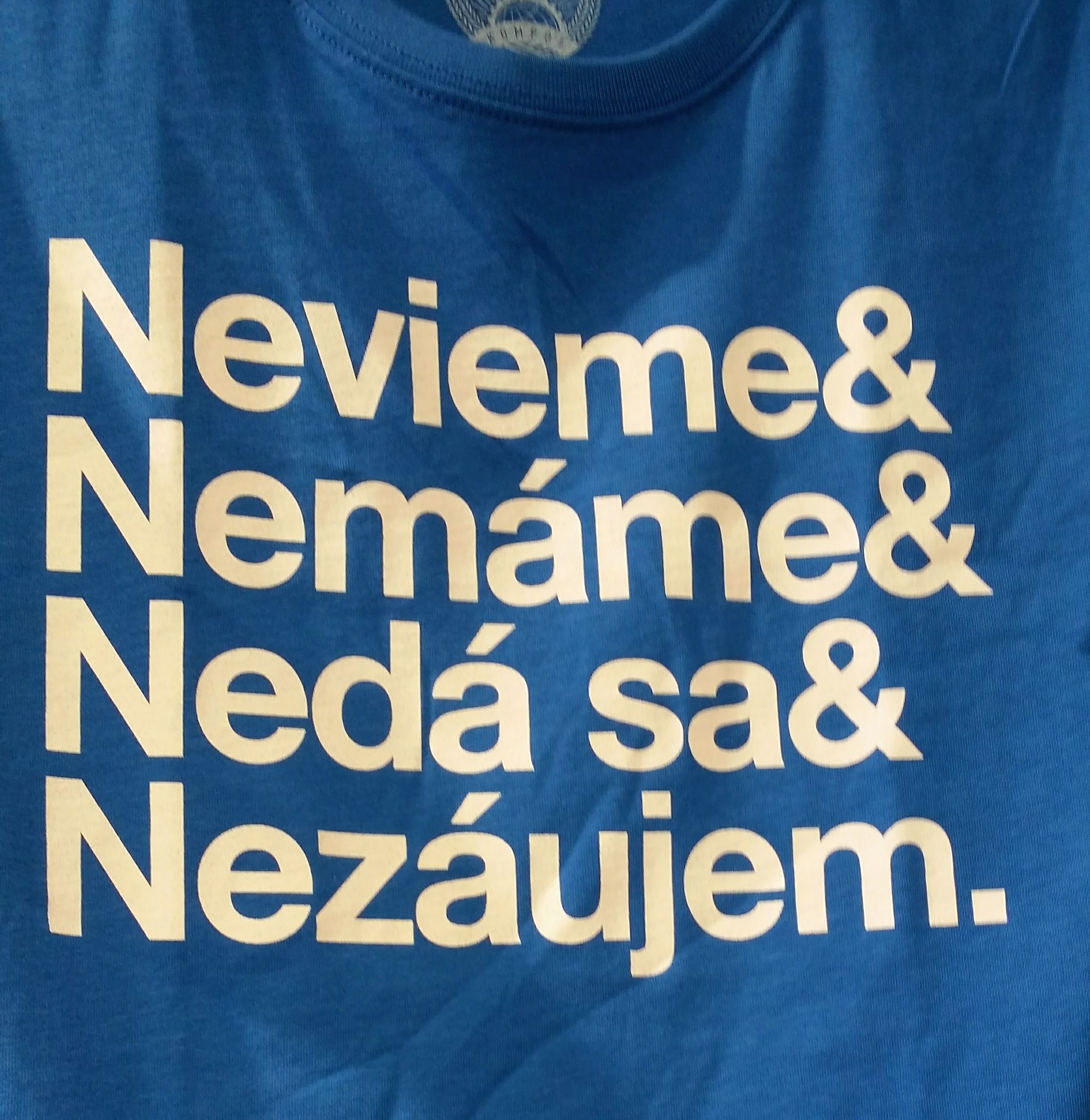A pessimistic definition of Slovakness on a T-shirt. (don’t know & don’t have & not possible & no interest)
Slovakia is a country of 5 million inhabitants, located in the centre of central Europe and bordering with Czech Republic, Austria. Hungary, Ukraine, and Poland (I hope you are insulted that I even mention this, but experience has taught me to really start with the basics). A farmer who was born in 1917 has been the citizen of 5 different states without ever leaving his home village in the Tatra mountains. Slovakia belonged to the Habsburg Empire for centuries, then became the junior partner of Czechia in the remarkably progressive the democratic Czechoslovak Republic. Slovakia, however, felt treated unjustly by Prague in many respects, which facilitated the emergence of the first independent Slovak Republic under protection and supervision of Fascist Germany. After the war, Slovakia was once again second to a Czecho-, albeit this time with a socialist face. After the peaceful Velvet Revolution of 1989, Czechoslovakia became democratic once more, and the Slovak part of the country seized the opportunity to again break away from Czechia in the 1993 Velvet Divorce.
What was celebrated as a happy end to a century of rapidly changing, oftentimes violent regimes turned out to be a pretty rocky road. Privatization and the introduction of free market principles have had the same effects here than elsewhere in the formerly socialist block: It has brought the country a boost in economic development and brought about some wealth. On the other side of the coin stand growing insecurity and austerity and thus striking inequality within the country. Whereas the Western part attracted major businesses such as several car manufacturers, as well as Amazon, Lenovo and IBM, the Eastern regions stagnate. Unemployment and emigration quotas are consistently high. And the Democratic politicians do not always approach their office with the sense of responsibility and fairness they owe their people. Ever since the political system changed, the country has barely seen a period without major corruption scandal. Understandably, many people have adapted the hopes and expectations they invest to reality – in other words, they stopped trusting politicians altogether.
The current government is a coalition of four parties, ranging from the Slovak national party to the center-left party of the Hungarian minority, Most-Híd. It is led by Robert Fico, officially a Social Democrat, by certain standards more of a noisy populist with a quite conservative and protectionist agenda who protects corrupt members of his cabinet and likes railing against intellectuals and the media. A worrying trend is the quick ascent of the ultra-right-wing party (L’SNS), the People’s Party – Our Slovakia, also known by the name of its controversial leader Marian Kotleba, a brute though. The repertoire of the party sounds sadly familiar – anti-Roma and immigrant agitation, national protectionism, conservative family politics, homophobia, and Euro-scepticism. The members don’t shun evoking fascist associations, patrolling trains in uniforms and using a neo-Nazi vocabulary of symbols.
But you don’t have to go into the heart of right-wing radicalism to find a certain uneasiness towards the new and foreign. This holds true especially with regard to different nationalities, skin colors, and religion. The public discourse on migration does show a certain variety, ranging from a skepticism to open racism. However, fear and rejection are consensus and barely leave any space for a calm and rational treatment of the subject. This became particularly tangible during the so-called refugee crisis of 2015. Slovakia, together with its partners from the Visegrad group, even proceeded to sue the EU for their refugee quota program. Slovakia accepted 8 asylum requests that year – fewer than in any year before. This raises one of the most delicate political questions my dissertation will inevitably touch upon: Is intolerance in Slovakia politically manufactured? Or does it reflect an actual sentiment which a big part of the population shares? The refugee crisis collided with the campaigns for the parliamentary elections in spring 2016. Migration, Islam and the alleged paternalism of the EU on the topic became the one and only campaign topic. The following statements were repeated ad nauseam, with only the formulations varying:
„Slovakia has no experience with diversity“„Islam has no place in a Christian country like Slovakia, multiculturalism is a lie“„Refugees only want to reach the rich states like Germany anyway“„They want to steal social benefits from poor Slovak pensioners“„We can’t even integrate our own Roma, how could we deal with people from an entirly different culture?“„Rape, crime, terrorism, Sharia, oppression of women etc.“
Voices that offered a well-balanced, less dramatic outlook were very rare on th political scene. Xenophobia and protectionism are thus ready channels to stimulate popular support. Very likely, populist tales of outward threat and deeply human fears of the unknown go hand in hand here.
Finding an answer to this question is a more complex project than it might seem because the field is broad and fragmented. The dominant discourse of intolerance, apparently, is not inescapable: Even if politicians rarely beg to differ on the migrant issue, single individuals and institutions very well do. Those actors, who query widespread stereotypes and investigate ways of a successful, harmonious coexistence in diversity, are some of the main protagonists of this blog. They do not fit into a coherent scheme. NGO-activists belong to this heterogeneous group as well as philanthropists motivated by their Christian faith, members of expat communities, entrepreneurs with a mission, engaged individuals with a good idea, and volunteers who think hard about doing the right thing and arrive at different conclusions than their neighbors.
